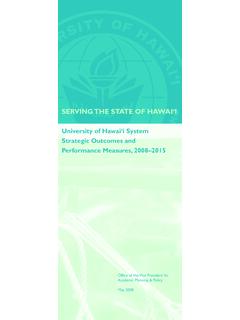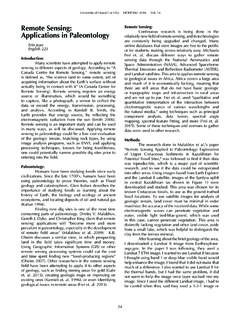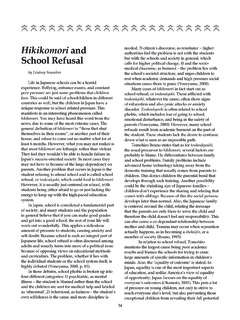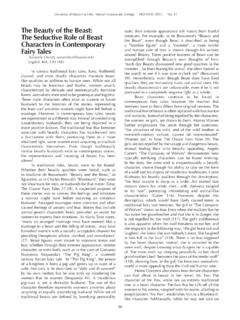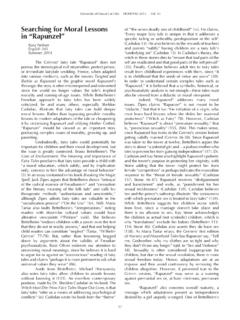Transcription of The Cause of Crime - University of Hawaii at Hilo
1 ; ; ; ; ; ; ; ; ; ; ; ; ; ; ; ; ; ; ; ; ; ; English 215 Final Project The Cause of Crime Anthony Holzman-Escareno Crime is an aspect of life that all citizens must deal with as it seems to have been around as long as civilization itself. Crime has ravished communities for centuries and one assertion is that Crime is more prevalent in poor inner-city neighborhoods than it is in equivalents that are more af uent. Finding the root source of this plague has been on the minds of criminologists and others for centuries. This is because the control, reduction, and prevention of Crime has been a major problem in our society and many others. There have been many different angles that have been studied as the potential Cause of Crime .
2 Currently, the three major aspects include a lack of education, living in poverty, and being raised in a single parent home. Each of these perspectives offer insight to Crime s true Cause , but it seems that none can stand alone. Crime is a complex issue that may stem from many sources, but a lack of education, generational poverty, and the rupture of family structure each seem to play a prominent role in criminal activity. Education is much more important today than it ever was. The quality and quantity of education a person receives is commonly viewed as a determinate of that person s success and/or way of life. Some believe that the length of one s education can distinguish those with a higher possibility of being incarcerated ( Education and Crime 1).
3 The disparity between the education levels of the inmate population and the general population are astounding. Only 18% of the general population have not completed high school or any equivalence, while 27% of federal inmates, 40% of state inmates, 47% of local jail inmates and 31% of probationers failed to do so (Harlow 2). The state of our society today stresses good schooling more than almost anything else and the inmate population in general seems to be a step behind the rest of society in the education department. One aspect of the relationship between Crime and education is that school is a place where children learn many important social skills ( Education and Crime 1; Lochner 1-3).
4 In the past, the main dwelling for socialization was a child s home, but as work becomes more demanding on parents, they lose valuable time with their children, therefore losing the ability to properly socialize them. Hence, children spend much of their time at school and get much of their socialization accordingly ( Education and Crime 1). Education may develop enough social skills to deter kids from engaging in Crime . School stresses many behaviors that are not very useful in the criminal world including, treating others with respect and striving to be a good citizen. Education also gives students a future-driven look on life, which will Cause them to contemplate the consequences of criminal activity more.
5 A future-driven individual is more patient and less likely to take the risk associated with criminal activity (Lochner 1-5). Another side of the correlation between education and Crime is that poor school performance or low intelligence is an indicator of future criminal behavior (Karpowitz and Kenner, 4; Weatherburn, 4; Fagan, 11). The Department of Justice believes that the typical offender is undereducated, unemployed and living in poverty before incarceration. Also, America s prisoners have a much higher illiteracy rate than our nation as a whole. Of the adult inmate population 19% are illiterate, compared to 4% nationally. In addition to this, up to 60% of the adult inmate population is functionally illiterate, compared to 23% nationally (Karpowitz and Kenner 4).
6 Also, of local jail inmates cited behavioral or academic problems as their reason for leaving school. Only of the general population, yet to complete high school, cited this reason (Harlow 3). Patrick Fagan believes that many future criminals have substandard verbal memories and trouble grasping concepts, not excluding those of morality. They have hardships learning reading and counting skills (11). Don Weatherburn also brings up the idea that criminals, in general, are less intelligent than their counterparts. He says that many believe criminal activity is linked with one s intelligence quotient or IQ. Having a low IQ is said to increase criminal activity by decreasing the capacity to comprehend consequences of such behavior.
7 The problem is that having a low IQ is also associated with poor school performance so the correlation between IQ and Crime could actually be related to performance rather than intelligence (4). Performing poorly in school is also associated with truancy, the next aspect of the education and Crime relationship. The next view on the relation between education and Crime is a dislike for school that eventually leads to truancy. Fagan quotes a professor 15 from Cambridge University saying, Youth who dislike school and teachers, who do not get involved in school activities, and who are not committed to educational pursuits are more likely than others to engage in delinquent behavior[;] those who display this lack of ambition usually begin skipping school and eventually drop out altogether (Harlow 11).
8 Truancy is linked to delinquency, but Lance Lochner poses a good question: do kids drop out to commit crimes or do they commit crimes because they dropped out (5)? Weatherburn says a possible link is that juveniles that are in school are under supervision and therefore cannot commit as many crimes as they could away from school. The opportunity is what causes youth to offend. He also says that the truancy and Crime association could be caused by truant students doing worse in school (4). Fagan believes that most juveniles have begun a serious apprenticeship in Crime before they even drop out of school (11). Education is also believed to reduce Crime amongst criminals as well (Karpowitz and Kenner 3).
9 As they stand now, recidivism rates in America vary between 41 and 71%. The most ef cient way to reduce recidivism is to educate prisoners. According to a National Institute of Justice report to Congress this is the best way to suppress recidivism. In 1997, The Three State Recidivism Study revealed a 29% reduction in recidivism among inmates that merely attended school. A 1994 State of Texas report also found that convicts who received their GED and vocational training had a 20% lower rate of re-offending (Kaspowitz and Kenner 4-6). Also, the same report found a correlation between college degrees and recidivism. The rate that inmates recidivate is much lower in inmates that have college degrees, standing at 12% (Kaspowitz and Kenner 4-6).
10 The type of degree also played a major role as the recidivism rate was in inmates who had Associates, of inmates with Bachelors, and 0% for inmates who held Masters Degrees. The State of Illinois found similar results as prisoners in college programs had a recidivism rate of , while the rate of a control group was and the rate of the general prison population was (4-6). Education not only can deter future criminals, but it can also discourage present criminals from re-offending and being re-incarcerated. Lochner estimates that if the average educational level was raised by just one year, state-level arrests could be reduced by 11%. This would also show by reducing various individual crimes.

